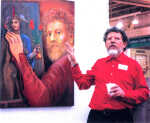Former Nevadan making mark in art world

Nevada Daily Mail
James McNeill Mesple' continues to make his mark in the art world.
The Nevada native, who was born here in 1948 and grew up in the town's environs, credits his fourth grade teacher, Madeline White, at Benton Elementary, and his high school art teachers, Mrs. Merle Frasier and Molly Murphy, for "setting me on the road."
The 1966 NHS graduate found his road led him to first, the University of Missouri, where he spent two years studying art and music, and then to Northeastern Illinois University in Chicago to finish his bachelor's in art in 1968.
After graduation from NIU, then known as Chicago Teachers College, he took a job as a teacher at Francis W. Parker School in Lincoln Park, Ill., staying for 10 years.
Following his time at FWP, he taught part-time at the Art Institute in the Studios Program.
Over the years, Mesple' has taught egg tempera workshops at Midway Studios, University of Chicago; North Central College: the BASIC Program (advanced studies for art teachers) at SAIC, and to graduate students at Northwestern University.
His own painting career accelerated when he began devoting all of his time to his artwork, in 1988.
Since then he has had numerous one-person exhibitions and been in probably more than 100 group shows, he recalled.
"Over the last 40 years, I have introduced over 33 solo exhibitions."
His latest exhibit, which ran from late June to mid-August, featured 23 of his figurative, narrative paintings at the Chicago Cultural Center in the Renaissance Court Gallery.
Titled Mythic Faces & Figures, these paintings explore themes of classical mythology, Shakespeare plays, and personal narratives, he said.
The paintings demonstrate his mastery of the mixed technique, which combines egg tempera and oil glazes resulting in luminous colors.
"This exhibition brings together two elements that have appeared in my art over the years, the human face and figure. Since antiquity, the human face has inspired art in diverse cultures in the form of masks, totems, geometric patterns in basketry and weaving, and of course the painted portrait. "Using faces and figures to create sequential narratives appears even before the cylinder seals of the Sumerians.
"Fayum encaustic portraits in ancient Egypt were painted with startling realism, which still amazes the viewer. The human form was an integral part of the art of the Classical world, including all the civilizations touched by the expansive Roman Empire.
"The human face and figure do indeed have a long history in art, but my own association with these images is much more personal.
"My interest in narratives and myths as the subject of my art began at an early age. I was drawing long before I could read and write. My father died when I was 6 years old, leaving my mother with seven children.
"We lived in the Missouri Ozarks and I was sent to spend my summers with my grandfather on his farm. My grandfather was born in 1873 and my mother was the youngest of his nine children.
"From him I heard stories in the evening about the animals, birds, and even the rivers -- the Marmaton, the Osage, the Missouri, and even the Mississippi, which he had visited once many years before.
"Stories about the deer, hawks, crows, raccoons, snakes, spiders, butterflies, hummingbirds, and eagles were passed down orally -- living threads from his Osage (Native American) heritage.
"I soon discovered classical art, and realized that Native American and Classical cultures share certain threads of similarity. Their narratives often contain heroes and heroines and even a trickster/messenger who battle the forces of good and evil.
"Both cultures looked upon nature and Mother Earth as very much alive and deserving of our respect. For a child, these stories inspired vivid dream images in vibrant colors, which to this day I strive to recreate on my canvases.
"Of course, the luminous colors of dreams are difficult to achieve in paint, and this has led me to experiment with a variety of materials and techniques over the years.
"I am always working toward denser and more saturated colors, which for me have deep symbolic meanings. I am always weighing the importance of the symbolic value of color versus its ordinary use as a descriptive element in a painting.
"Usually, the symbolic meaning wins out. In my work, cool colors imply feminine polarities, while warm colors indicate masculine polarities. The symbolic associations are dovetailed into the narrative of the myth in ways that I hope communicate and add to the layers of meaning in the story, just as the layers of colored glazes provide illumination to the painting."
